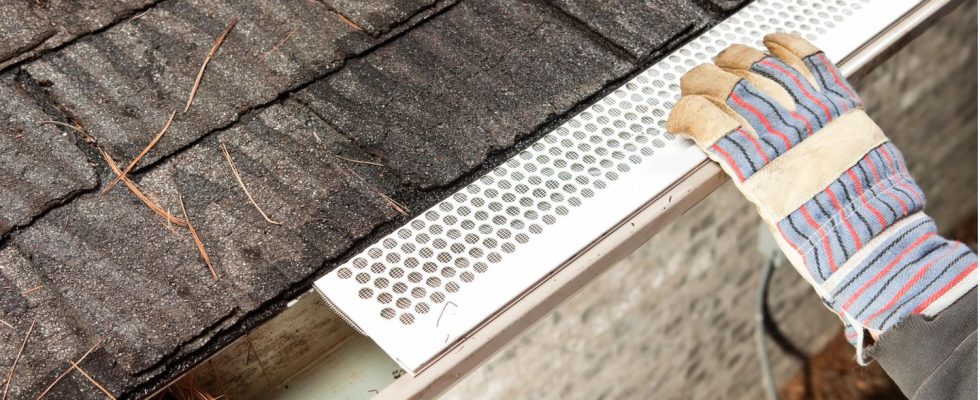Quick help
Leaf protection for gutters: These simple solutions are available
A protective grille is intended to prevent leaves and branches from collecting in the gutter
© BanksPhotos / Getty Images
Trees regularly lose leaves and spread them over forests and meadows, streets and roofs – much to the chagrin of many homeowners. Because in combination with other organic waste such as twigs or moss, they clog the gutters. Then at the latest it will be time for leaf protection.
It’s not just gutters that fall victim to the masses of leaves, but also downpipes: these are vertically installed pipes that are used to direct rainwater away from the roof. In both cases, the water can no longer drain away properly and often finds another path – usually along the facade – downwards. The clogged pipes promote moisture damage to the home. To prevent this, you can install (or have) special leaf protection installed on your gutters and downpipes. Below we will introduce you to different variants for home use.
1. Leaf guard
For older zinc gutters this will work Leaf guard Made of high quality polypropylene recommended. According to the manufacturer, it is stable yet flexible, so it can easily be clamped into the gutter and secured with special clips. Alternatively, you can also use leaf protection elements made of thermoplastic: This arched grilles should be robust and dimensionally stable, break-proof and weather-resistant. It can also be tailored individually. Both variants are available in different sizes.
2. Leaf catcher strips
Alternatively, for gutters made of plastic or metal (size NW 100 to NW 150, also for box-shaped ones). Leaf catcher strips made of polyethylene can be used for protection. These are attached to the gutter bead using an integrated clip system and keep small branches and large leaves away. This model is available in three different colors: black, brown and gray. Each element is one meter long, so you should measure in advance how many leaf trap strips you need for your gutters.
3. Leaf protection net
This offers another variant Leaf protection netdepending on the manufacturer too Leaf protection mat called. It is usually made of weather-resistant plastic (polyethylene) and is attached to the gutter with special clamping rods. The net is significantly more flexible than leaf protection grids or strips, meaning the mesh can carry less load. The advantage here is that you receive a whole roll that you can cut (and trim) individually. However, pay attention to the width of the nets.
4. Downspout protection
Not only gutters, but also downpipes can become blocked by too many leaves and coarse dirt. To prevent this, there is a special pipe protector: This is a kind of plastic leaf sieve that is simply clamped into the downpipe opening. This is intended to ensure rain drainage even in autumn. It is important for you to know that it is Downpipe protection available in different sizes and designs. Please pay attention to the dimensions stated by the respective manufacturer.
5. Gutter brush
In contrast to the first four variants, the so-called “gutter caterpillar” is not stretched over the gutter, but is placed directly into it. This is to prevent leaves and dirt from being flushed into the pipes and clogging them. In addition, the brush-like structure is intended to prevent birds from building their nests in the gutter. This UV-resistant Gutter brush for example, consists of black polyprop fibers. It is only available in one length but with different diameters.
Helpful purchasing tips for leaf protection
Before you decide on leaf protection for your gutter, you should keep the following three criteria in mind:
The width
Measure your gutter first before ordering leaf guards. The width of the pipes is particularly important for optimal protection against leaves and other organic waste. For a gutter brush, however, the diameter of a gutter is by far the most important factor.
The material
As mentioned at the beginning, leaf protection is usually made of plastic – or metal (e.g. zinc, stainless steel, copper). In this case, it may well happen that certain metals do not “get along”. In other words, unfavorable combinations of different metals can promote contact corrosion.
The mesh size
Every leaf guard has a certain mesh size. These can be larger and sometimes smaller. For this reason, you should think carefully in advance about what type of leaves you will be dealing with in autumn – more precisely: which leaves should the protective grille ideally keep from the gutter?
You might also be interested in:
This article contains so-called affiliate links. Further information are available here.


